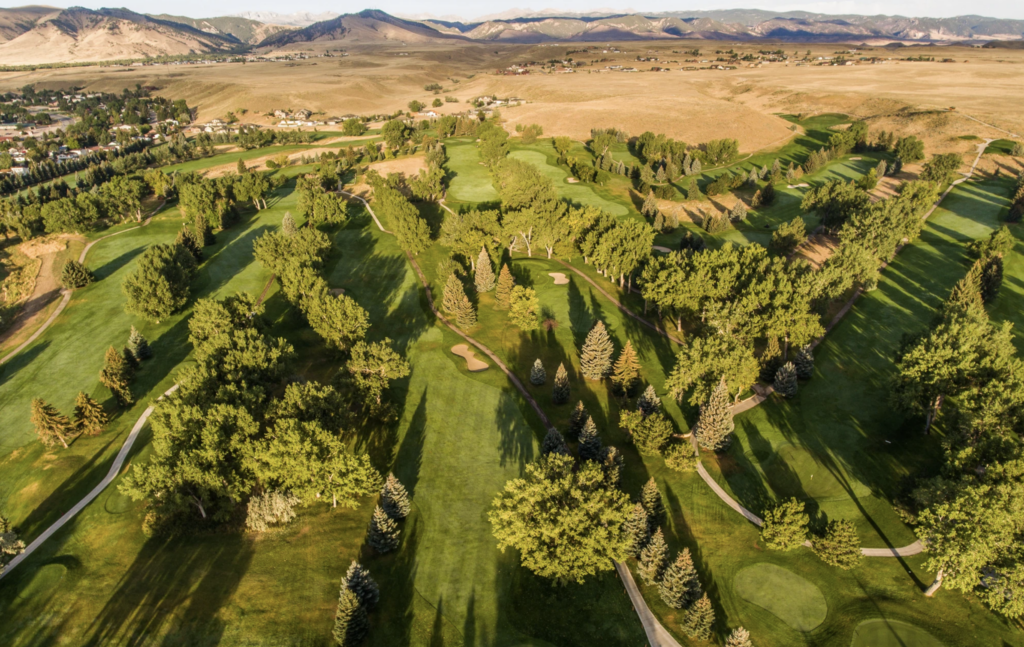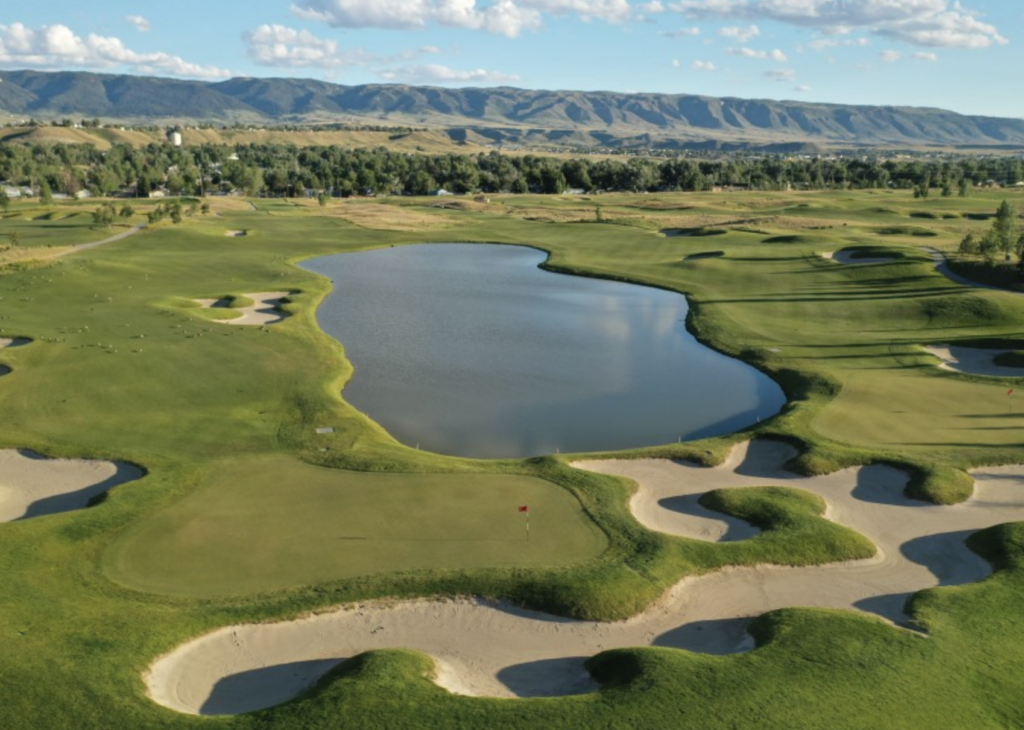
Buffalo Golf Club
Wyoming might not be on the short list of destinations for golfers but it certainly should be. There’s really great courses here – about 70 in total in the least populous of the United States — as well as other activities that visitors can indulge in before and after a round of golf.
The towns of Sheridan and Buffalo are a long way from just about anywhere while the city of Casper is one of the state’s true destinations. Sheridan has two courses — the Powder Horn, a 27-hole destination stay-and-play managed by Troon, and the city-owned and operated Kendrick Municipal Golf Course. Buffalo has a surprisingly good eponymously named facility that belongs on your must-play lists, and Casper is the home of the terrific Three Crowns Golf Club, which is fun, playable and unique because of its past and setting.
A trip to this part of the western United States allows golfers to get back to nature and gives them a little taste – even when driving on an Interstate Highway at 80 miles-per-hour — you’ll see distant mountains bordering miles and miles of rolling golden-grassed fields and prairies. You almost feel as if a huge herd of buffalo chased by Native American hunters on horseback might be just over the next hill or around the next bend.
Three nines produce varied experiences at The Powder Horn
The centerpiece of The Powder Horn, located in Sheridan in one of the nation’s top residential golf communities, is its nationally recognized, 27-hole golf course. Noted for its three distinct nines — the Mountain and the Stag, both opened for play in 1997, and the Eagle, which debuted in 2002 — The Powder Horn has earned continued accolades from numerous golf publications and just about everyone who has made the effort to see the property.
Designed by Dick Bailey, each of The Powder Horn’s nines has its own personality.
With a nod to the game’s Mecca, St. Andrews, the Mountain Nine features a small replica of the famous Swilcan Burn Bridge as well as large greens, 30 sizable sand bunkers and the open rolling terrain of a Scottish links. Woodlands and wetlands surround the property’s old red barn to create target golf with Old West flair on the Stag Nine. And on Eagle, the need for length and creative shots are mixed together across meadows and creek-side terrain.
The community and its courses are situated at 3,800 feet elevation at the base of the Big Horn Mountains. Every hole offers incredibly panoramic views of the not-so-distant peaks and surrounding areas, and the course challenges with native rough along fairways.
The development occupies 900 unspoiled acres. Little Goose Creek meanders through and every measure was taken to preserve the beautiful land, so much so that the courses have been designated as a National Audubon Cooperative Sanctuary.
Each of the nines is a par-36, but the Eagle is the longest at 3,653 yards from the tips. The Stag is carded at 3,491 yards and Mountain is 3,443 yards. Multiple elevated tees make Mountain the easiest of the three.
Since the first tee was put into the ground at The Powder Horn, the accolades for Bailey’s work have been loud and numerous. The course has been listed among Golfweek’s “America’s Best Courses You Can Play,” Best Residential Golf Courses, Top 100 Modern Golf Courses and as Wyoming’s Top Course.
The Powder Horn is a marvelous place to play and live. With stay-and-play options that offer two-days full of golf and two nights’ stay, you owe it to yourself to get out to Wyoming to give the place – and this course – the once-over. If you do, you may never leave.

Powder Horn
Up & down at Kendrick Municipal Golf Course
Designed by Edward A. Hunnicutt and opened in 1932 on land donated to the City of Sheridan by its namesake, Wyoming Governor and United States Senator John B. Kendrick, Kendrick Golf Course offers views of both the mountains to the west and Sheridan to the east.
When the gift was made in 1930, the Sheridan Press noted, “With a plentiful supply of water, it is expected that the new golf course will have grass greens, which, added to its beautiful location, will make it one of the finest courses in the West.”
Yes, the course still has grass putting surfaces, which have plenty of subtle breaks to make your time on them very interesting.
The par-72 course plays to a seemingly friendly 6,667 yards from the tips, but it’s constantly buffeted by strong winds from off the mountains. Its seemingly docile rating of 71.6 and slope of 123 quickly increases as the wind beats on your ball and gets in your head. Kendrick was renovated in 1980 by Carl Theussen and Frank Hummel and the routing is a strong one.
The back nine at Kendrick is, by far, the tougher side, thanks to more challenging par 4s (where the front nine has only one two-shotter – the 432-yard second – at 400 yards or more, the inward nine has three) and two demanding par-5s.
The 513-yard 11th (the No. 1 handicap hole) has a huge lake that must be crossed on the approach (best to do so with a short iron than an attacking fairway metal from long range). The twice-turning 17th, the longest hole on the course at 585 yards, is perhaps Kendrick GC’s best offering.
Kendrick is an absolutely beautiful course, with tree-lined fairways and a great variety of holes, all kept in fine condition and played in relative isolation. It’s been rated as one of the state’s top-five courses by Golf Digest and is worth the high regard and is a good companion course to The Powder Horn when in the area.
Buffalo Golf Course: if you know, you know
Smack dab in the middle of Buffalo sits the stunningly green and deceptively difficult Buffalo Golf Course, a testy par-71 that plays just 6,556 yards from the back tees.
Opened for play in 1928 and later renovated in 1980 by Hummel and Bill Poirot, Buffalo Golf Course features multiple elevation changes, with a lake and bunkers stoking its difficulty, and large cottonwood trees, evergreens and aspens adding to its beauty. Water comes into play on 11 holes, thanks mostly to the stream that winds its way through the compact property.
The facility boasts incredibly scenic views of the Big Horn Mountains to the west. The front nine has three par-3s, and that is not the only aspect of the course that is unusual. The par-3 second, already a challenge at 191 yards, must be played through a narrow evergreen-squeezed opening that guards the green from about 50 yards off the tee box. The 148-yard par-3 fourth is played off an elevated tee to a green some 75 feet below, and then there’s the dogleg-right, 456-yard fifth — the No. 1 handicap hole on the course and its longest par-4.
The back nine at Buffalo features its shortest (the 133-yard 10th) and longest (the 237-yard 15th) par 3s. Both are tough if the pins are cut close to the danger. The two par-5s on this side can also be attacked, especially the straight-as-a-string closer, which rolls 525 yards uphill toward a deep green backed by a huge bunker.
According to the folks in the pro shop people travel from far and wide to play at Buffalo Golf Course. In a single season the pros see players from nearly every state and a dozen foreign countries. “It seems everyone hears about the course through word of mouth,” Poirot said. “But, having opened in 1928, Buffalo Golf Course has had a few years to generate a buzz.”

Buffalo Golf Course
Three Crowns Golf Club highlights site’s remediation
Casper’s best golf course, Three Crowns Golf Club, was built on the site of one of the region’s largest and longest-operating oil refineries smack dab in the middle of town, and directly adjacent to the North Platte River. It has garnered awards for both its design and as a remediation project at the location of the former Amoco Oil Refinery.
Where once there were tanks and towers and heat exchangers and thousands of miles of pipe, there is now a gleaming and green, par-72, 7,065-yard Robert Trent Jones Jr.-designed course. The layout has 110 acres of manicured turf and 45 acres of native grasses. Eight lakes – four of which help remediate water pollution – come into play on 14 holes, and 84 bunkers filled with white sand punctuate the golfscape while adding challenges galore.
Three Crowns Golf Club occupies land that still contains millions of gallons of refinery product scheduled for recovery over the next two decades.
One of Jones Jr.’s biggest challenges in designing Three Crowns Golf Club was adjusting to the requirement that cuts could not be made deeper than six feet. In preparing the site, 3,000 miles of pipe and 400,000 cubic yards of concrete were removed, and contaminated soil was capped with six feet of clean dirt.
Landowner BP Products North America, which had merged with Amoco, then installed a remediation system; an intricate arrangement of pumps, oil separators, monitoring and recovery wells and other technology is integrated across the course to treat and test all water, ensuring that it meets environmental standards before it is returned to the North Platte River.
Mounding separates the golf holes from each other, lend an isolated feel to the course and are covered in native grasses that turn wheat-colored in summer to beautifully set off the verdant fairways.
There are more than 100 recovery wells working at Three Crowns Golf Club, many on the footprint of the golf course. They produce not only oil (about 30 barrels a day are still taken out of the ground), but water as well.
Opened in 2005 with much fanfare, Three Crowns Golf Club is a jewel to play and a tough course for anyone. The track crosses the old rolling refinery site with a combination of long par-3s (all at least 200 yards), monster par-5s (three are 575 yards or longer) and a collection of mostly short par-4s (the longest of which is just 425 yards). The front nine is played in a 3-3-3 sequence of one-, two- and three-shot holes.
Three Crowns Golf Club and Casper sit at about 5,150 feet of elevation, so take that into consideration when selecting clubs. And because the wind frequently roars out of the mountains to the west, expect some weather changes as well.

Three Crowns GC

